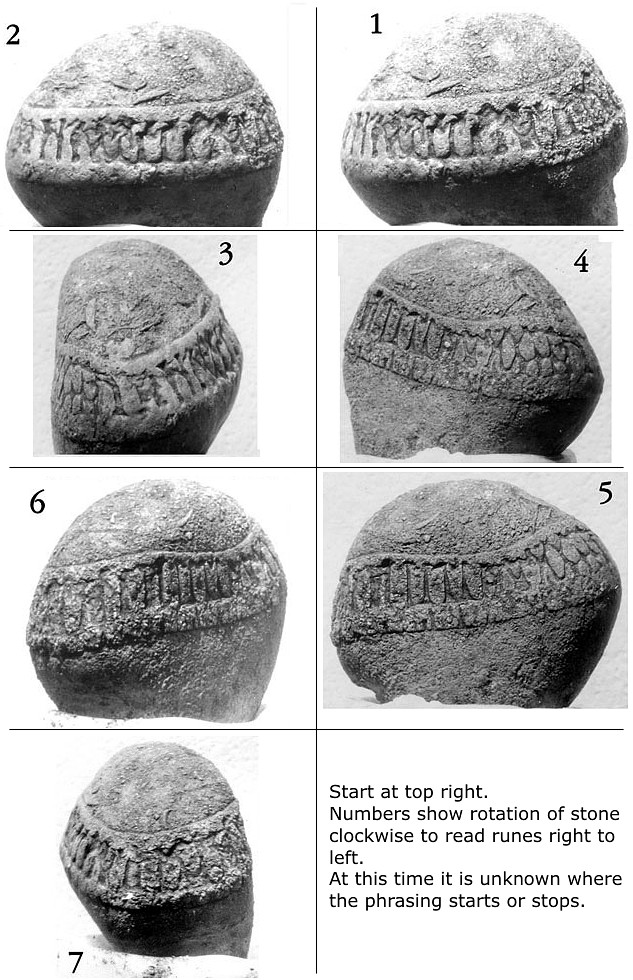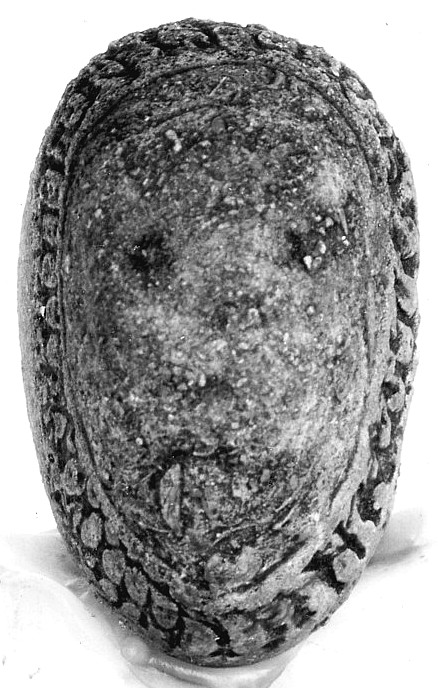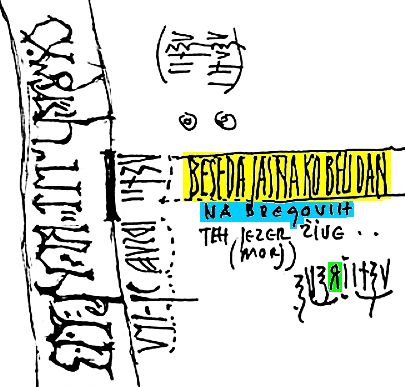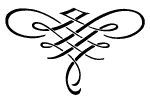|
This stone is filed for safekeeping at the University of Minnesota archives, Minneapolis, MN. It was originally found in the town of Roseau (Minnesota) in the late 1920’s. The geographical coordinates of Roseau are 48°51' N. Latitude and 95°42' W. Longitude. The stone had a face with runes around it.
Some quotations: ... This stone has a history of interest. The story of its finding and subsequent study was written down by its main (and only serious) researcher, John Jager, in the mid 1930’s. For introduction here is Jager’s biography. > http://special.lib.umn.edu/findaid/xml/naa021.xml < (Scroll down to “Biographical Note”)
This person was, first, a great architect who designed many of the public buildings still standing in Minneapolis/ St. Paul, Minnesota.
Jager was also a genius scholar interested in world-wide anthropology and epigraphy. He was also one of the first pioneers to put forth the idea of cultural diffusion and global travel, to North America, by the ancient mariners. John Jager wrote a formal telling of the stone’s history. A rough draft of this was found typewritten by Jager on the old style, manual, carbon-ribbon machine (see below).
The final presentation of the stone’s history was part of an exhibit that remains on show at the Roseau County Historical Society Museum in Roseau, MN. > http://www.roseaucohistoricalsociety.org/ <
The finished draft was hand calligraphed, personally by John Jager, onto a large card and can be seen there today. It has always been a point of irritation to the Roseau museum that the stone’s whereabouts had been missing for the last 59 years, that they have not been the ones to have the chance to display it. The stone’s whereabouts have only come to light in February of 2011, a trail of some mystery.
The original finder of the Stone, one Mr. Jake Nelson of Roseau, had contacted the Hon. C.P. Bull (of State Dept of Ag, St. Paul). Bull had, earlier, been an original resident of Roseau. After talking it over, those two decided to mail the RS to their joint acquaintance, Mike Holm, the Minnesota Secretary of State at the time. Holm was also a previous resident of Roseau, so the three all knew each other. Mike Holm then took the Roseau Stone to U of Mn and Dr. Jenks in Anthropology to see if it could be interpreted.
As explained in the story-link, above, Jager received the Roseau Stone in 1927 from Professor Jenks. John Jager was an intellectual, active and hands-on scholar of epigraphy and ancient script; where as Jenks primarily reflected text-book recitation.
Holm became close friends with John Jager, over the course of the intense study of the Stone, and they remained so for the rest of their lives. The Roseau Stone had then, since 1926 or so, been the personal property of Mike Holm, and remained in his possession until he passed away in 1952.
In those days of early 20th century, Archaeology was a very new discipline. It had not gained the growth yet to have a useable data-base for research. Much of Jager's findings were "cutting edge" theorization being proven by personal discoveries and long hours of artifacts cataloging, cultural comparison and analysis.
His notes mentioned that the runes on the Roseau Stone, in some places, were in two rows, one on top of each other. Major and minor in size. Jager also identified the Runes NOT as Scandinavian, but as medieval, southern European… and therefore with a root origin from the Balkans and Slavic regions; from the developing Christian era not pagan Viking. The runes JJ identified on the Roseau Stone are ancestors to scripts used later in Russia. As such, Jager, being a native of southern Austria (bordering on Slavic country) and fluent in Russian, was exactly the set of eyes the Stone needed to start cracking its message. In his notes, he was comparing some of the segments to Russian phraseology.
The Roseau Stone is quite small, even though it looks large and detailed in the photographs. Here are the pictures that survived in a library file that was located a few years ago. After his death, most all other private works of John Jager (outside of his public architect career) such as his complete notes, photos, and conclusions about the Stone, were burned when his widow died and could not protect them anymore.
This one file, with the photographs and a few rough note cards, was hidden away in a different library far from the house in the ‘Cities. It was John's personal, anthropological file-drawers in St. Paul that were burned by order of strange government commands. That is a part of history that cannot be reclaimed or rewritten.
These picture frames, shown on this web page, were taken June 19,1927, by John Jager in St. Paul. These photographs were taken of the Roseau Stone before the surface was destroyed, later, by acid. [This editor has not personally seen any current photos to compare the condition between the photos of ’27 and today’s stone on display at U of Mn. John Jager and Mike Holm, in letters from the 1930’s, both describe a marked, drastic reduction of detail and surface texture from the acid bath applied by Jenks and Stauffer. So far, other photos of the RS that I’ve seen online, have been reproductions and webpage captures of this original file of photos on this webpage. The Roseau Historical Society Museum corresponds to say the Roseau Stone on display at the U of M appears undamaged…? ] These are the best images of all John's captures, according to his judgment. He then used them creatively in the darkroom.
Jager manually created the "Ribbon" using the old photographic methods of the time. Today we would use computer and Photoshop to do that. He did not have that luxury. Therefore, do not trust Jager’s "Ribbon" for total accuracy in image. Where he marked it in pencil is where the breaks and image overlaps are. Because of the process, the seams are blurred or have doubled imagery when magnified. Trust the individual pictures for more accurate interpretation.
Shortly after the photographs were taken, John gave the rock to the University professors Jenks (of Anthropology) and Stauffer (a professor of Geology). They destroyed the artifact by "cleaning it" in an acid bath, which reportedly ate away most of the evidence on the pebble. They did not want the idea to get out that there was pre-Columbian contact with American natives. This is all mixed up in the U.S. mainstream collegiate’s smothering of these ideas, from the 1800’s to present day. There are bitter opponents in the national University/College system to any advancing of awareness of pre-1492, Old World diffusion to North America even today, in spite of all the logical, scientific evidences to the contrary.
Jager was crushed, outraged and distraught that the beloved item of his last 20 months work, research and near obsession was ruined because of “professional” ignorance, if not intentional device. On the photo of the ribbon, J.Jager writes: "Roseau Stone Minn" and "DAMNED BE JENKS AND STAUFFER!" Jager's trademark logo-initial testifies to witness that John wrote the notes and created the picture (there in 1930). He adds "Developed inscription ribbon, pieced together for the same picture plane." [This editor is not claiming these particular comments on U of MN personnel of the past, only reporting history as it happened.]
Records show that the ruined stone was once again, for perpetuity after that, in the ownership and possession of Mike Holm. Again, both Holm and Jager had expressed in letters to other people that the RS was not in the condition it was before its encounter with its geological examination. As it turned out, Holm lived a good time longer than Jager. When the Holm died, the stone supposedly was filed, with all the rest of Holm’s personal souvenirs, at the State Historical Society in St. Paul, MN (The capitol city of Minnesota). But the RS went missing altogether, no sign of its existence for the next 5 decades. It vanished from record from 1952 until just now, 2011.
In recent years, the Roseau Stone has caught the attention of avocational scholars the world over. Awareness of its potential to change North American text book history has increased. If Columbus was “the first”, then how did a medieval artifact rest in the hands of Native Americans and be buried in Minnesota centuries before he arrived? Questions were being raised. The rock was long lost and nobody knew where it was.
Surprisingly, it has re-surfaced across the Mississippi River in Minneapolis, in the keeping of U of Minnesota. The family of Theodore Blegen, a few years ago, gifted the Elmer L. Anderson Library with a packet of Blegen’s personal possessions. Among the donated items was the Roseau Stone, labeled as such. U of Mn did not immediately recognize the importance of the listing of one small rock in their numbered box 26. With the modern techno update of their catalogue system, all Library listings came online for any curious persons to read, world wide. One independent researcher called the awareness of ELA Library to the presence of the Roseau Stone in their files.
The Roseau Stone has now been added to an ongoing exhibit at the ELA Library entitled Headwaters
of History (ASC Joint Exhibit)
The odd part would seem, that, as many folks know, Blegen was a researcher of the Kensington Rune Stone, not the Roseau Stone. Blegen was critical of the KRS and was among the literate and vocal opponents against the presence of Old World cultures in North America before Columbus. It seems unusual that the Roseau Stone should show up in his particular file boxes at this late date. Blegen would have been one of the people to brush the controversy under the rug. In the 1930’s, as director of the Minnesota Historical Society, he bent over backwards to avoid confrontation over the KRS. Blegen wrote a book trying to logically negate the presence of 12th century Europeans in North America, let alone Minnesota. He would have been one to discount the evidence such a thing as the Roseau Stone represented, not keepsake it.
Mike Holm was the one who had retained the Roseau Stone as a dear memory of an old friend and colleague. So why would the RS show up, now, in the Blegen files? The family reports that Theodore Blegen received the Stone “shortly before he died”. TB did not die until 1969. Where was the stone in the missing 17 year gap between Holm’s passing and Blegen’s possession? More questions to be accounted for. News here as it happens.
However, the main thing is, goodness to heavens, we in the avocational and professional network have it to work with again! Perhaps newer technologies such as infra-red microscopy, atomic mass spectroscopy or fluorescence can be brought to play and re-disclose some of the original surface loss the Stone has suffered.
All we have, now, to prove the Roseau Stone ever had such sharp, clear, defined and miniature carvings are these pictures and the few rough notes of Jager's that have been saved. Feel free to spread the photos and story around. Share with other researchers and scholars. The more copies there are, the more chance the information has of surviving to the next generation who will appreciate, not fear, the idea of humans knowing more than we give them credit for about our globe; far earlier than the European Renaissance.
If there are any serious researchers, linguists and or epigraphers who would like to have an e-file of the last, remnant notes anyone knows of left behind by John Jager’s RS study, they can snail mail a postcard to me, in English, with their mailing address and e-mail addy. We will connect. Write to: The Equinox Project P.O.Box 434 Perley, MN 56574-0434
ROSEAU STONE: A brief Case-History of the so-called ROSEAU STONE (by John Jager, circa 1935)
This stone has been found near Roseau, Minnesota, before 1927 by Mr. Jake Nelson. The authenticity of its finding is known to Mr. P.O. Frykund, Clerk of Court in Roseau; Mrs. Martin, a sister of the finder; Mr. C.P. Bull, State Department of Agriculture, St. Paul; and Hon. Mike Holm, Secretary of our State, who personally investigated the case in loco. Hon. Mike Holm is the owner of this stone, also keeper and recorder of all facts connected with this archeological find from the Stone-Age of Minnesota.
In 1927 Hon. Mike Holm submitted this stone to the Department of Anthropology of the University of Minnesota, Prof. A. E. Jenks, for investigation.
John Jager, a member of the Institute of Architects, living at 6 Red Cedar Lake in Minneapolis received this monument from Prof. A. E. Jenks as to "what you can make out of it..." for being a student of the so-called Stone-Age literature and its Paleography... subjected this stone to painstaking scrutiny under all angles of approach. The motto of his guidance for doing this work remained at all times the archeologist maxim: HOW EASY IT IS TO SEE A PART, ... HOW HARD, TO SEE THE WHOLE.
First of all, the investigator ascertained those basic compositional features, which always characterize man's art in seeking and giving its expression through matter. This stone, in its form, by man's selection responded to evaluation for its PROPORTION (up and down), for its DIRECTION (front and rear) and for its MASS-SYMMETRY in front observation, (right and left.)
Under these three agenda the form disclosed A MINIATURE HUMAN HEAD of such dimensional limitations: proportion 2 inches, [5 cm] by direction 1 3/8 inches [3 cm] by symmetry (all over) 7/16 inch. [sic]
[ed note: I have seen the pictures of the stone and it would seem to be an unintentional "typographic error" by J.Jager in this rough draft, created on a mechanical typewriter, to have skipped a "1" inch indication before the "7/16 inch" notation. Over all frontal symmetry would appear in photos to be 1 & 7/16ths inch or approximately 3.6 cm.]
In looking en-face we discover in further, a band of AN INSCRIPTIONAL RIBBON average 3/8 of an inch wide, [1 cm] contouring the entire face oval a seam or border of a headgear, well recognized by students of medieval costume. This ribbon is masterly selected for its graphic propensities.
The stone in itself is admirably chosen for ies petrographical virtue: degree of resistance to the elements. An artist in stereothomy [sic] and naturalist, the producer of this miniature document must have been.... [ed note: Jager continues throughout all notes where I’ve seen him use this vocabulary word, he spells stereotomy with an “h”. Dictionary says “the art or science of cutting solid bodies, esp stone, into desired shapes.”]
For two years, Prof. Jager reviewed the Roseau-Stone, in his spare time. Numerous photographs were taken of it, in diffused light, and under sunbeam for holding of its artificial characteristics... in whole and in detail ....
The ribbon of inscription became available in enlargement in a developed flat, by being pieced together from units. This laid the basis for a PALEOGRAPHIC approach concerning the inscription.
There is no doubt about the existence of an archaic script, of which said kinds are known to indigenous Europe. The scripter must have been a master in handling LIGATURES. There are actually two lines of text in evidence; the upper one, distinct and pronounced, the lower fragmentary or inter-functioning with the upper, much in the character as observed on runic calendars (see, "Calendario Runnico," Museum of Bologna, 4 photographs). [ed. – This must have been an exhibit in that era, which Jager went to see or was personally familiar with, being an international traveler. At any rate, he was not imagining his resources, but basing his conclusions on solid, historical findings.]
There are DISTINCT LETTERS in evidence, bringing even to our age a positive proof and authority that this monument with its painstakingly carved inscription is genuine and outstanding as a work of man of long ago..., damaged as it be.
It is regrettable that this stone that resisted the ravages of ages in an extreme climate, when found in Roseau, Minnesota became at once an object of "doubt" even as to its genuine existence, understood for its high compositional virtue, unappreciated for its historical significance, ... in short,...authoritively [sic] degraded by a scientifically narrow and abberated [sic] posterity...
It so happened: In 1929 Jager sent all his data as described above to Prof. A. E. Jenks, returning to him also the Roseau-Stone at the same time.
On January 14, 1930 A.E.Jenks called Jager on the telephone. The following conversation issued:
Professor A. E. Jenks: "The stone which supposedly was found in Roseau and which you (Jager) contend to be an artifact, bearing and inscription by human hand (passed on to professor C.R. Stauffer, Department of Geology in our University for investigation.) Prof. Stauffer thoroughly cleaned that stone and analyzed it petrographically. He ascertained beyond any doubt that the stone does not show any work by human hand. There is no ribbon of writing on it, the kind you believe, He is in position to show you dozens of just such stones in his department, all works of nature in their designs -- fully concurring his opinion.
Jager: "Do you truly believe it?"
Prof. Jenks: "I must, as it comes from an authority. We are not any more interested in this stone. (I shall see that it is returned to Mike Holm...")
Through kindness of Mr. C. P. Bull I obtained again the Roseau Stone from Hon Mike Holm desirous to ascertain the degree of mutilation which it must have experienced at the hands of "authorities." They surely gave it an acid bath and brushing, whereby all its archeological patina became lost, its scriptural finesse obliterated. Researched away, forever.
It is fortunate that there are photographs of this stone in existence before it struck the University Laboratories. Archeologically minded men should never had permitted such a rouch handling of an object, unique and strange, and little understood.
Herewith I return the Roseau Stone to Hon Mike Holm, its owner. Attached to it is an arrow found by Mr. C. P. Bull upon the site where the stone had been found before. The time will come when more of such characteristic artifacts shall appear. The soil of Minnesota may yield them proving that there was an undisputed connection of our Northwest with Europe of long ago. Such "strangers" as the little stone of Roseau should be saved from subersion [sic] [ed. subversion]
The archeology of a new day should accord them an impartial documentation. There is still more work ahead.. and "authorities" better be careful because the judgment by posterity is still ahead, upon the Ribbon of Time.
Signed,
John Jager 6 Red Cedar Lane Minneapolis, Minnesota
John Jager's original photos.
See separate photos: http://dominorus.narod.ru/foto_1.jpg http://dominorus.narod.ru/foto_2.jpg http://dominorus.narod.ru/foto_3.jpg http://dominorus.narod.ru/foto_4.jpg http://dominorus.narod.ru/foto_5.jpg http://dominorus.narod.ru/foto_6.jpg http://dominorus.narod.ru/foto_7.jpg
The face
The inscription on The Roseau Stone was deciphered by John Jager (see the fragment of the photo below).
The text marked by color is the text in Russian
Russian Runes: Mystery of Roseau Stone
Article in the Russian newspaper
Copyright © 2006 Vladimir Pakhomov Updated: 25 June, 2011
The URL of this webpage is http://dominorus.narod.ru/roseau.html |




